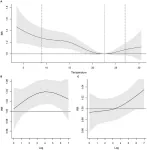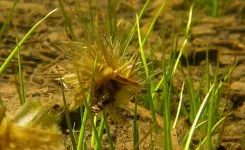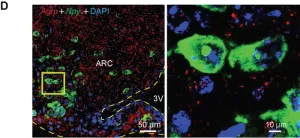(Press-News.org) In testing the genetic material of current populations in Africa and comparing against existing fossil evidence of early Homo sapiens populations there, researchers have uncovered a new model of human evolution — overturning previous beliefs that a single African population gave rise to all humans. The new research was published today, May 17, in the journal Nature.
Although it is widely understood that Homo sapiens originated in Africa, uncertainty surrounds how branches of human evolution diverged and how people migrated across the continent, said Brenna Henn, professor of anthropology and the Genome Center at UC Davis, corresponding author of the research.
“This uncertainty is due to limited fossil and ancient genomic data, and to the fact that the fossil record does not always align with expectations from models built using modern DNA,” she said. “This new research changes the origin of species.”
Research co-led by Henn and Simon Gravel of McGill University tested a range of competing models of evolution and migration across Africa proposed in the paleoanthropological and genetics literature, incorporating population genome data from southern, eastern and western Africa.
The authors included newly sequenced genomes from 44 modern Nama individuals from southern Africa, an Indigenous population known to carry exceptional levels of genetic diversity compared to other modern groups. Researchers generated genetic data by collecting saliva samples from modern individuals going about their everyday business in their villages between 2012 and 2015.
The model suggests the earliest population split among early humans that is detectable in contemporary populations occurred 120,000 to 135,000 years ago, after two or more weakly genetically differentiated Homo populations had been mixing for hundreds of thousands of years. After the population split, people still migrated between the stem populations, creating a weakly structured stem. This offers a better explanation of genetic variation among individual humans and human groups than do previous models, the authors suggest.
“We are presenting something that people had never even tested before,” Henn said of the research. “This moves anthropological science significantly forward.”
“Previous more complicated models proposed contributions from archaic hominins, but this model indicates otherwise,” said co-author Tim Weaver, UC Davis professor of anthropology. He has expertise in what early human fossils looked like and provided comparative research for the study.
The authors predict that, according to this model, 1-4% of genetic differentiation among contemporary human populations can be attributed to variation in the stem populations. This model may have important consequences for the interpretation of the fossil record. Owing to migration between the branches, these multiple lineages were probably morphologically similar, which means morphologically divergent hominid fossils (such as Homo naledi) are unlikely to represent branches that contributed to the evolution of Homo sapiens, the authors said.
Additional co-authors include Aaron Ragsdale, University of Wisconsin, Madison; Elizabeth Atkinson, Baylor College of Medicine; and Eileen Hoal and Marlo Möller, Stellenbosch University, South Africa.
END
New UC Davis research using DNA changes origin of human species, researchers suggest
New model for human evolution suggests Homo sapiens arose from multiple closely related populations
2023-05-17
ELSE PRESS RELEASES FROM THIS DATE:
A new understanding of human origins in Africa
2023-05-17
There is broad agreement that Homo sapiens originated in Africa. But there remain many uncertainties and competing theories about where, when, and how.
In a paper published today in Nature, an international research team led by McGill University and the University of California-Davis suggest that, based on contemporary genomic evidence from across the continent, there were humans living in different regions of Africa, migrating from one region to another and mixing with one another over a period of hundreds of thousands of years. This view runs counter to some of the dominant theories about human origins in ...
Low temperatures increase the risk of sickness absence, especially for women, young people and third sector professionals
2023-05-17
A retrospective study of temperatures in the province of Barcelona reveals that low temperatures increase the risk of going on a period of sick leave, due in particular to infectious and respiratory diseases. The study, carried out by researchers from Center for Research in Occupational Health (CISAL) and the Department of Medicine and Life Sciences at UPF (MELIS); the Barcelona Institute for Global Health (ISGlobal), an institution supported by the "la Caixa" Foundation and CIBER of Epidemiology and Public Health (CIBERESP), shows that the sectors of the population most affected are women, young people and ...
Newcomers may change ecosystem functions – or not
2023-05-17
In a study tracking climate-induced changes in the distribution of animals and their effects on ecosystem functions, North Carolina State University researchers show that resident species can continue managing some important ecological processes despite the arrival of newcomers that are similar to them, but resident species’ role in ecosystem functioning changes when the newcomers are more different.
The findings could lead to predictive tools for understanding what might happen as climate change forces new species into communities, such as the movement of species from lower to higher latitudes or elevations.
“Species ...
NYU Abu Dhabi researcher contributes to the discovery of an Earth-sized exoplanet in the habitable zone with volcanic activity
2023-05-17
Abu Dhabi, UAE: – A team of scientists led by researchers at the University of Montreal has recently discovered an Earth-sized exoplanet, a world beyond our solar system, that may be carpeted with volcanoes and potentially hospitable to life. Called LP 791-18 d, the planet could undergo volcanic outbursts as often as Jupiter’s moon Io, the most volcanically active body in our solar system. The team includes Mohamad Ali-Dib, a research scientist at the NYU Abu Dhabi (NYUAD) Center for Astro, Particle, and Planetary Physics.
The planet was found and studied using data ...
Automated window shades show potential for significant energy savings, Illinois Tech study finds
2023-05-17
CHICAGO—May 17, 2023—Automated insulating window shades can cut energy consumption by approximately one-quarter and may recoup the cost of installation within three to five years, according to a landmark study conducted by Illinois Institute of Technology researchers at Willis Tower. The study, funded by ComEd, showcases a promising path for sustainability and energy efficiency in architectural design.
Temperature regulation typically accounts for 30–40 percent of the energy used by buildings in climates similar to Chicago. The research team, led by Assistant Professor of Architectural Engineering Mohammad ...
Found: a likely volcano-covered terrestrial world outside the Solar System
2023-05-17
A large international team led by astronomers at the Trottier Institute for Research on Exoplanets at Université de Montréal (UdeM) today announced in the journal Nature the discovery of a new temperate world around a nearby small star.
This planet, named LP 791-18 d, has a radius and a mass consistent with those of Earth. Observations of this exoplanet and another one in the same system indicate that LP 791-18 d is likely covered with volcanoes similar to Jupiter’s moon Io, the most volcanically active body in our Solar System.
“The discovery of this exoplanet is an extraordinary ...
Odd cells found in lungs of patients with idiopathic pulmonary fibrosis
2023-05-17
A pair of internationally renowned stem cell cloning experts at the University of Houston is reporting their findings of variant cells in the lungs of patients with Idiopathic Pulmonary Fibrosis (IPF) which likely represent key targets in any future therapy for the condition.
IPF is a progressive, irreversible and fatal lung disease in which the lungs become scarred and breathing becomes difficult. The rapid development and fatal progression of the disease occur by uncertain mechanisms, but the most pervasive school of thought is that IPF arises from recurrent, subclinical lung ...
What did the earliest animals look like?
2023-05-17
For more than a century, biologists have wondered what the earliest animals were like when they first arose in the ancient oceans over half a billion years ago.
Searching among today's most primitive-looking animals for the earliest branch of the animal tree of life, scientists gradually narrowed the possibilities down to two groups: sponges, which spend their entire adult lives in one spot, filtering food from seawater; and comb jellies, voracious predators that oar their way through the world's oceans in search of food.
In a new study published this week in the journal Nature, researchers use a novel approach based on chromosome structure to come up with ...
Researchers pinpoint brain cells that drive appetite in obesity
2023-05-17
A team at the Garvan Institute of Medical Research has discovered a group of brain cells that boosts appetite when there is a prolonged surplus of energy in the body, such as excess fat accumulation in obesity.
The researchers discovered that these cells not only produced the appetite-stimulating molecule NPY, but they in fact made the brain more sensitive to the molecule, boosting appetite even more.
“These cells kickstart changes in the brain that make it more sensitive to even low levels of NPY when there is a surplus of energy in the body in the form of excess fat – driving appetite during obesity,” explains Professor Herbert Herzog, senior ...
Receipt of medications for chronic disease during the first 2 years of COVID-19
2023-05-17
About The Study: This study of 18.1 million beneficiaries of fee-for service Medicare found that, in contrast to in-person health services, receipt of medications for chronic conditions was relatively stable in the first 2 years of the COVID-19 pandemic overall, across racial and ethnic groups, and for community-dwelling patients with dementia. This finding of stability may hold lessons for other outpatient services during the next pandemic.
Authors: Nancy E. Morden, M.D., M.P.H., of the Geisel ...
LAST 30 PRESS RELEASES:
Scientists trace microplastics in fertilizer from fields to the beach
The Lancet Obstetrics, Gynecology, & Women’s Health: Taking paracetamol during pregnancy does not increase risk of autism, ADHD or intellectual disabilities, confirms new gold-standard evidence review
Taking paracetamol during pregnancy does not increase risk of autism, ADHD or intellectual disabilities
Harm reduction vending machines in New York State expand access to overdose treatment and drug test strips, UB studies confirm
University of Phoenix releases white paper on Credit for Prior Learning as a catalyst for internal mobility and retention
Canada losing track of salmon health as climate and industrial threats mount
Molecular sieve-confined Pt-FeOx catalysts achieve highly efficient reversible hydrogen cycle of methylcyclohexane-toluene
Investment in farm productivity tools key to reducing greenhouse gas
New review highlights electrochemical pathways to recover uranium from wastewater and seawater
Hidden pollutants in shale gas development raise environmental concerns, new review finds
Discarded cigarette butts transformed into high performance energy storage materials
Researchers highlight role of alternative RNA splicing in schizophrenia
NTU Singapore scientists find new way to disarm antibiotic-resistant bacteria and restore healing in chronic wounds
Research suggests nationwide racial bias in media reporting on gun violence
Revealing the cell’s nanocourier at work
Health impacts of nursing home staffing
Public views about opioid overdose and people with opioid use disorder
Age-related changes in sperm DNA may play a role in autism risk
Ambitious model fails to explain near-death experiences, experts say
Multifaceted effects of inward foreign direct investment on new venture creation
Exploring mutations that spontaneously switch on a key brain cell receptor
Two-step genome editing enables the creation of full-length humanized mouse models
Pusan National University researchers develop light-activated tissue adhesive patch for rapid, watertight neurosurgical sealing
Study finds so-called super agers tend to have at least two key genetic advantages
Brain stimulation device cleared for ADHD in the US is overall safe but ineffective
Scientists discover natural ‘brake’ that could stop harmful inflammation
Tougher solid electrolyte advances long-sought lithium metal batteries
Experts provide policy roadmap to reduce dementia risk
New 3D imaging system could address limitations of MRI, CT and ultrasound
First-in-human drug trial lowers high blood fats
[Press-News.org] New UC Davis research using DNA changes origin of human species, researchers suggestNew model for human evolution suggests Homo sapiens arose from multiple closely related populations







